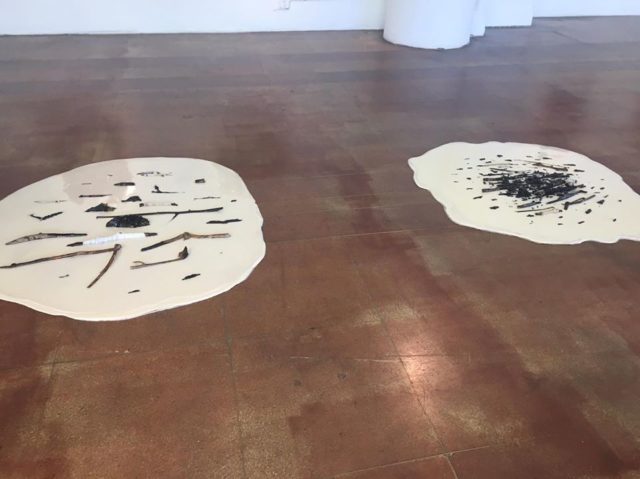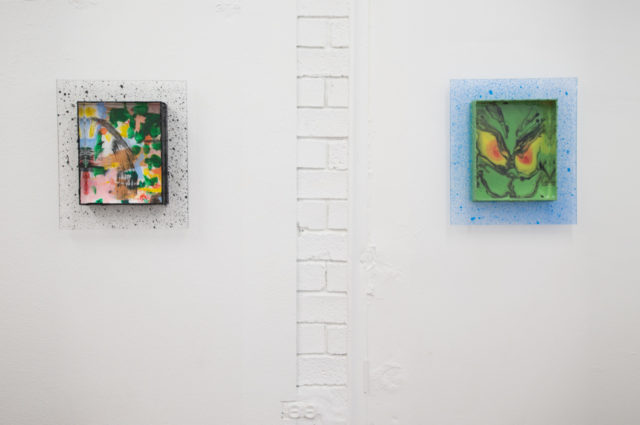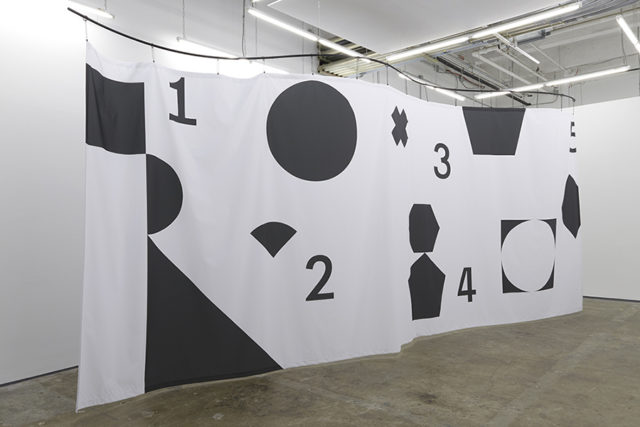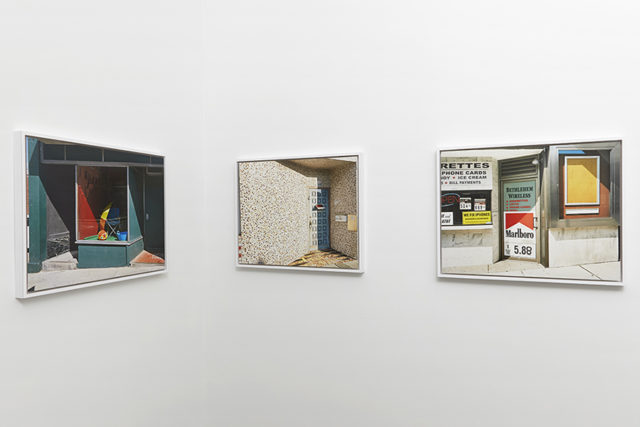
Installation View, Vadis Turner, Bells and Burn Piles, Geary Contemporary, 2016 (Courtesy the artist and Geary Contemporary)
Is the West Village still worth visiting for art? I asked myself this question the other day, after realizing that there’s been something of an art world exodus from the neighborhood in the past couple years. Most recently and notably, Gavin Brown’s Enterprise left their West Village space for two galleries in the Lower East Side and Harlem in the summer of 2015. But this shift out of the area began even earlier. Harris Lieberman Gallery closed in 2013, Sperone Westwater moved to the Bowery in 2010 and numerous lesser-known galleries either left or closed in between. Just trying to find a current list of West Village galleries is a study in dead links and farewell letters.
A few shuttered doors don’t tell the whole story, though, so I headed out to the West Village to find out for myself what’s out there. After an afternoon of exploring the neighborhood’s September shows, I’m happy to report that there’s plenty worth heading out to see. The results of my trip below:
Vadis Turner: Burn Piles and Bells

Vadis Turner, Artifacts and Remains, 2016, breast milk, resin, charred sticks, ribbon, tacks (photo by author)
Geary Contemporary
185 Varick Street
New York, NY
On view until October 8, 2016
When you decide to use a bodily fluid like breast milk as an artistic material, you risk overpowering everything else in the exhibition. That’s exactly what happened at my first stop in Nashville-based artist Vadis Turner’s solo show Burn Piles and Bells at Geary Contemporary.
Her two floor-based puddles, Remains and Artifacts, are placed precariously side-by-side in the center of the gallery. Even though they appear shiny and wet, the two pools consist of a solid mixture of resin, paint and breast milk with burned sticks and other singed materials at their core. They look alternately like a spill in a grocery store milk aisle and prank rubber vomit. They are physically nauseating, but not quite appalling enough to feel fresh.
If it was Turner’s intent to disgust, she certainly succeeded. However, it was at the cost of filtering all her other works through the lens of abjection. The show also features a new series of resin-based paintings, containing swirls and dashes of ribbon and flecks of ash. With their pink and red coils, in conjunction with Remains and Artifacts, the paintings resemble organs like intestines or an umbilical cord.
Turner clearly has more nuanced ambitions for the understanding of these paintings than just in-your-face depictions of our internal anatomy. The juxtaposition of the soft ribbon and the hardened resin acts as a feminine response to the typical masculinity of abstraction. But this use of gendered craft material in feminist art is nothing new, and in fact, feels antiquated.
Turner’s previous 2013 exhibition Past Perfection at Geary was much more engaging, presenting monumental ribbon paintings that addressed similar themes in a more subtle way (ie, no breast milk). Glimpses of this work can still be seen in her delicate ribbon drawings that occupy the edges of the current show, but who can notice when you’re trying not to step on white pools of resin vomit?
Nicholas Sullivan: Peanut

Installation view of Nicholas Sullivan’s Peanut including New American Painters Mask and Grinch Mask, 2016 (Courtesy the artist and Mumbo’s Outfit)
Mumbo’s Outfit
185 Varick Street (inside Geary Contemporary)
New York, NY
On view until October 8
While the galleries are few and far between, many West Village spaces–luckily–host project spaces or multiple shows within one gallery. This gives the neighborhood a more populated, energetic and artistically diverse feel that it may otherwise have. One of these project spaces is Mumbo’s Outfit inside Geary Contemporary, which featured Nicholas Sullivan’s cartoon-centric exhibition Peanut.
Rather than cute, nostalgic representations of childhood favorites, Sullivan’s small paintings of Spongebob and the Grinch look as if they just came off a serious bender. They’re covered in dripping paint, a swirl of psychedelic colors and smudged facial features. It’s like turning on Nickelodeon after dropping LSD.
Referred to as masks and sometimes even adorned with fake hair, what makes these paintings more conceptually interesting is that they gesture towards an evolving understanding of constructed identity. They reflect how we relate to much of the world, especially as children, through pop culture. Maybe you were too old for Spongebob, but you probably had a treasured Barbie or G.I. Joe backpack that became a marker of your school age personae.
Sullivan, though, goes a step further to show how, as adults, we’ve rejected cartoons in favor of artistic styles. Take, for example, New American Painters Mask, which depicts a conventional abstract painting with swooshes, splatters and dots. While, at first, a stylistic shock, it places art on the level of cartoons. In the context of Sullivan’s cartoonish identity-building, the work reveals that artists and viewers now relate to our favored aesthetics as an integral part of our identities. He’s eerily correct.
Gareth Long: He Knew Many Things, But He Knew Them All Badly
John Lehr: Selections from ‘The Island Position’

Gareth Long, He Knew Many Things, But He Knew Them All Badly (Counting Waves), 2016, UVA inkjet on fabric, custom curtain rod (Courtesy the artist and Kate Werble Gallery)
Kate Werble Gallery
83 Vandam Street, New York, NY
On view until October 22 (Long) and November 8 (Lehr)
Gareth Long’s He Knew Many Things, But He Knew Them All Badly and John Lehr’s Selections From ‘The Island Position’ in Kate Werble Gallery prove just how much the cultural relevancy of an exhibition matters. The success of Long’s exhibition and the problems in Lehr’s show depend on timeliness alone rather than the technical prowess of their work.
Located in Kate Werble’s main gallery, Long’s show delved into stupidity. This seems like a perfect theme for an exhibition in the fall of 2016. It’s no mistake that the press release starts with a 2013 tweet by Donald Trump boasting how his “IQ is one of the highest.” Putting politics aside, Long’s interest in our continued ignorance even in the wake of increasing technology and accessible knowledge remains wholly relevant.
The exhibition’s lengthy title derives from lost Homer comedy that follows a man, Margites, who tried to count all the waves in the sea even though he could only count to five. After learning about its obscure inspiration, the various multidisciplinary works in the exhibition come together. For example, Long’s central sculpture He Know Many Things, But He Knew Them All Badly (Counting Waves) seems, on first glance, like a math nerd’s shower curtain. However, the work combines Margite’s five numerals with geometric shapes resembling educational toys. Spanning the entire front gallery and obscuring a pencil drawing on the far wall, the curtain becomes a monument to blind ambition and impossibility.
This futility is further reflected in Long’s video Square Peg/Round Hole 3, which is such a simplistic concept that it barely needs explaining. The looping video shows a primary colored 3-D model of a square peg aimlessly trying to jam itself into a round hole. The repetitive video becomes an exercise in failure worthy of a Samuel Beckett play. Even with all our technological prowess, we still can’t solve this old puzzle.

Installation view of John Lehr, Selections From ‘The Island Position,’ 2016 (Courtesy the artist and Kate Werble Gallery)
The timeliness of Long’s exhibition directly clashes with the old school boredom of John Lehr’s exhibition Selections From ‘The Island Position’ in the project space. The exhibition presents a selection of photographs of old storefront facades on the main streets of towns throughout the United States. Documenting cigarette advertisements in gas stations and other window displays, there’s little to distinguish these images from the Americana of Walker Evans’ later color works.
This series marks a shift way from Lehr’s prior more ambiguous and industrial abstract photographs. While the current work in Kate Werble retains a bit of his interest in geometric abstraction with the blocks of color in storefront signs, his recognizable and nostalgic subject matter overwhelms any interest in form. Instead, they seem anachronistic, particularly in contrast to his earlier, more contemporary work and Long’s resonant exhibition nearby.


Comments on this entry are closed.